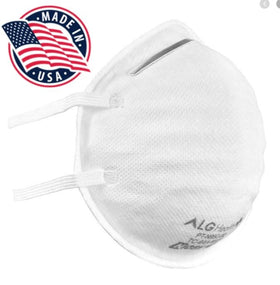
Anticipated CDC Recommendations Regarding N95 Masks Stir Concern
Among Healthcare Professionals Healthcare Workers Caution Against Easing Mask Guidelines in Medical Settings, Citing Potential Risks to Patients and Providers.
Nurses, researchers, and workplace safety officers are expressing concerns about potential reductions in protection against the coronavirus and other airborne pathogens in hospitals due to new guidelines proposed by the Centers for Disease Control and Prevention (CDC).
The CDC's advisory committee has been updating its 2007 standards for infection control in hospitals throughout the year, prompting outrage from healthcare professionals and scientists after releasing a draft of its proposals in June. The draft controversially suggested that N95 face masks are equivalent to looser surgical face masks in specific settings. It recommended that doctors and nurses only need to wear surgical masks when treating patients infected with "common, endemic" viruses, such as those causing seasonal flu.
Originally scheduled for a public vote on August 22, the committee postponed the decision until November. Once finalized, the CDC will convert the committee's assessment into guidelines, typically followed by hospitals across the United States. Concerns were raised by the public about the CDC's direction, particularly as COVID-19 cases have been on the rise, leading to increased hospital admissions and deaths.
Gwendolyn Hill, a research intern at Cedars-Sinai Medical Center, emphasized the importance of measures like N95 masks, ventilation, and air-purifying technology in reducing COVID-19 transmission within hospital premises. Alexander Kallen, chief of the Prevention and Response Branch in the CDC's Division of Healthcare Quality Promotion, stated that the draft guidelines are not final, and they welcome feedback to develop guidelines that prioritize the protection of patients, visitors, and healthcare workers.
In June, the CDC's Healthcare Infection Control Practices Advisory Committee presented a draft citing studies suggesting no difference in infection rates between N95 and surgical masks among health providers. However, this conclusion contradicts the CDC's 2022 report, which found that N95 masks were significantly more effective against COVID-19 than surgical masks. The committee's categorization of airborne pathogens, recommending surgical masks for "common, endemic" viruses, including coronaviruses causing colds, raised concerns among researchers and occupational safety experts.
In response to the proposed guidelines, Kaitlin Sundling, a physician and pathologist at the University of Wisconsin-Madison, expressed shock at the suggestion of needing more studies on the effectiveness of N95 respirators. This sentiment was echoed by Cal/OSHA, whose rules on protecting at-risk workers might conflict with the CDC's proposals. Researchers and safety experts found perplexity in how the committee categorized airborne pathogens, particularly in suggesting surgical masks for certain viruses and questioning the appropriateness of universal mask-wearing policies in hospitals. Clarification provided by Kallen revealed that the committee had placed coronaviruses causing colds in the suggested category but had not yet included the coronavirus causing COVID-19.
The committee's subsequent classification encompassed viruses during a "pandemic-phase," where the pathogen is novel, and limited immunity exists through infection or vaccination. For this category, the recommendation was for health workers to wear N95 masks when treating patients. The highest level of protection, designated for pathogens like those causing measles and tuberculosis, was deemed necessary due to their ability to spread more extensively than lower-tier threats, and an N95 mask was suggested.
Virologists have criticized the committee's classifications, stating that they lack biological merit. The mode of a pathogen's spread is not determined by its commonality, as even common viruses can pose risks to vulnerable populations. Viruses like SARS-CoV-2 can travel significant distances through microscopic droplets suspended in the air, as evidenced by large COVID outbreaks in facilities like prisons and long-term healthcare facilities.
In a letter to the CDC committee, Eric Berg, the deputy chief of health at Cal/OSHA, expressed concerns about the committee's assessment, highlighting the challenges in classifying infectious aerosols and their unpredictable behavior. The committee juxtaposed its evaluation of N95 masks with acknowledged drawbacks. Citing a Singapore study, the draft mentioned that nearly a third of healthcare personnel, primarily nurses, reported negative effects such as acne due to the masks, especially in hot and humid conditions and during prolonged shifts. The study's authors recommended addressing these issues through better-fitting masks and rest breaks instead of discarding the use of N95 masks.
Dr. Noha Aboelata, CEO of Roots Community Health Center in Oakland, California, concurred, suggesting alternative strategies such as improved mask design and enhanced testing. She emphasized the need to avoid giving patients COVID-19 when they seek medical care. A letter signed by hundreds of healthcare professionals, including Aboelata, expressed concerns to CDC Director Mandy Cohen in July, cautioning against potential weakening of protections in hospitals. The signatories warned that reducing reliance on N95 masks could have repercussions on emergency stockpiles, leaving doctors and nurses vulnerable, similar to the challenges faced in 2020 when mask shortages fueled infections. The letter also noted over 3,600 health workers' deaths in the first year of the pandemic in the United States, as reported in a joint investigation by KFF Health News and The Guardian. These concerned healthcare professionals hope the committee will reconsider its report considering additional studies and perspectives before finalizing its recommendations in November. Referring to the draft, Rocelyn de Leon-Minch, an industrial hygienist for National Nurses United, expressed concern that codifying these standards of care could have a disastrous impact on patient safety and the ability to respond to future health crises.


